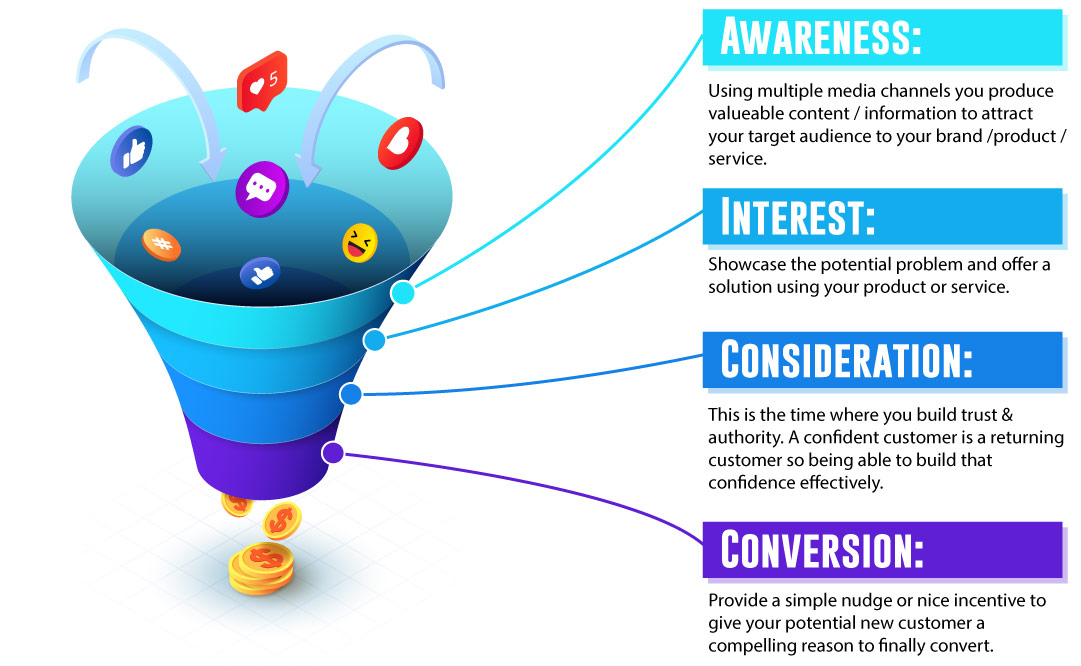Building Effective Marketing Funnels
Improve Your Marketing ROI
Building effective marketing funnels improve and accelerate your growth online
Optimized or build new effective marketing funnels for your business
Let's Get Started
Do you have an amazing product or offer an incredible service but not receiving as much orders or leads as you would like?
You may need to look at your marketing funnels.
What is a marketing funnel?
A marketing funnel is a pre-planned system designed to attract, inform and ultimately convert potential customers (or clients) to your brand, product or service.
Here is how to simply visualize a "Marketing Funnel":
A Simplified Marketing Funnel

What is a Marketing Funnel?
Maybe you've heard the term before, often referred to as marketing funnels, this is primarily a term used to define a set course of desired actions for your online visitors. Marketing funnels tend to overlap with customer journey's and provide actionable events throughout the funnel. These can vary in objective and length of run depending on the product or service and are most commonly implemented across multiple channels. They play a key role into building effective user experiences, provide critical information and often times a well planned and executed marketing funnel can produce incredible results.
Building Effective Marketing Funnels
Awareness:
The first stage of the marketing funnel is awareness. This is where people who have a certain problem become aware of your brand, products or services. They get to know about you, your company, your brand and the solutions you can potentially provide them and the cost in which to do so. Awareness campaigns can take shape in a multitude of ways. They could see you on social, find you in a google search, listen to you on a podcast, discover your channel or even attend a conference or trade show.
No matter the reason how they found you, they now know you exist. In fact, if the specific problem frustrates them enough, a few (most likely <1%) may even become customers or clients right away.
Interest:
The second stage of the funnel is interest.
At this stage, your potential customers have been somewhat engaged with your product or brand. They’ve consumed your content, and now they are eager to find out more. They want to dig deeper into the subject and are looking for more information and most importantly trust.
Your typical converting customer will likely:
Refine their searches by using more specific Google search terms. An example would be, instead of searching for “how to promote your website,” they may begin looking for SEO-specific topics like “proper page setup” and “best SEO practices”; At this stage they are looking for experts and influencers to learn more and begin building confidence in their decisions.
The ability to be able to rank your content or serve these customers, answering these specific search keyterms so they find your content will position your brand/ product or service as the expert they want to follow and learn more from.
Consideration:
The third stage of the marketing funnel, consideration.
At this point, your customers know their problem and they most likely have a few options for potential solutions. And they also know that YOU can provide that solution for them.
There is just one caveat.
Simply because they know what you do and how you could help, certainly doesn’t mean they will choose you. The reality is: there are plenty of possible solutions for your customers to choose from, what is it you are doing to build confidence and assurance to your potential customers?
They often will look at alternatives. This is especially true for big ticket items.
Knowing everything about the iPhone does not mean you will choose it over the next android device.
So your job at this critical point is to convince them you are the right person, product or company for their problem.
Conversion:
The fourth and final stage of the marketing funnel is the conversion. After careful consideration your customers are "almost" convinced you are the right solution for their problem.
All you have to do is to give them a final ‘push’—a compelling reason for them to “buy”, “subscribe” or contact you directly to begin the relationship.
A tried and true method is by utilizing urgency. If a product will be going out of stock soon, you can gently remind them. (Please don’t fake this!);
Ensure that your checkout experience is smooth and easy;
Offering them a discount to persuade them to buy is by far the most common way we have seen people attempt to convert their customers and while this method can work, we wouldn't advise our customers to use it initially as it can often have an opposite effect on the customer buying cycle and overall confidence of a brand or product. An easy alternative would be to provide additional information, money-back guarantees or another value-added incentive they would receive upon subscribing or purchasing.
If the buying experience is well thought out and pleasant, your prospects will happily make the purchase.
The Conversion stage could be a good point to include some cross sells / upsells. Basically trying to increase the average order value (AOV), upselling is selling your customers add-ons to the products they’re already buying. This can be done effectively but needs to be well thought out before implementation as a poorly designed upsell can lead to a drop in conversions.
